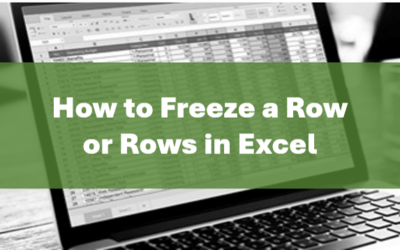Check Out These Easy Ways to Select using the Name Box in Excel
by Avantix Learning Team | Updated November 8, 2021
Applies to: Microsoft® Excel® 2010, 2013, 2016, 2019 and 365 (Windows)
The Name Box is located to the left of the Formula Bar in Microsoft Excel. It normally displays the name of the active cell. You can enter directly in the Name Box to quickly select cells or even objects.
Recommended article: 10 Excel Flash Fill Examples (Extract, Combine, Clean and Format Data with Flash Fill)
You can use the Name Box to:
- Select one or more cells
- Select rows or columns
- Name a cell or range of cells
- Navigate to a named cell or range
The Name Box can be resized by dragging its right edge to the left or right.
The following are 10 great ways to use the Name Box to select in Excel.
1. Select a cell
To select a cell, type the cell reference (such as a1) in the Name Box and press Enter.
2. Select a contiguous range of cells (method 1)
To select a range of cells, type the range in the Name Box using a colon (such as a1:b20) and press Enter.
3. Select a contiguous range of cells (method 2)
To select a range of cells, type the range in the Name Box using two periods (such as a1..b20) and press Enter.
4. Select a non-contiguous range of cells (method 1)
To select a non-contiguous range of cells, type the ranges in the Name Box using colons and commas to separate the ranges (such as a1:b20,d1:d20) and press Enter.
5. Select a non-contiguous range of cells (method 2)
To select a non-contiguous range of cells, type the ranges in the Name Box using two periods and commas to separate the ranges (such as a1..b20,d1..d20) and press Enter.
6. Select intersecting ranges (method 1)
To select only the cells of two ranges that intersect, type the first range in the Name Box using a colon, press the Spacebar, type the second range in the Name Box using a colon (such as d1:d15 a4:f12) and press Enter.
7. Select intersecting ranges (method 2)
To select only the cells of two ranges that intersect, type the first range in the Name Box using two periods, press the Spacebar, type the second range in the Name Box using two periods (such as d1..d15 a4..f12) and press Enter.
8. Select entire columns or rows
To select entire columns, type the first column in the Name Box, type a colon or two periods, type the second column (such as a:c) and press Enter.
To select entire rows, type the first row in the Name Box, type a colon or two periods, type the second row (such as 1:4) and press Enter.
9. Name a cell or range of cells
To name a cell or range of cells using the Name Box:
- Select the cell or cells you wish to name.
- In the Name Box, type a name (names cannot have spaces).
- Press Enter.
10. Select named cells or ranges
To select a named cell or range:
- Click on the arrow to the right of the Name Box.
- Select the named cell or range you wnat to select from the drop-down menu.
The Name Box is a great tool in Excel and can save you a lot of time.
Subscribe to get more articles like this one
Did you find this article helpful? If you would like to receive new articles, join our email list.
More resources
How to Convert Text to Numbers in Excel (5 Ways)
How to Use Flash Fill in Excel (4 Ways with Shortcuts)
How to Insert Multiple Rows in Excel (4 Fast Ways with Shortcuts)
How to Delete Blank Rows in Excel (5 Fast Ways to Remove Empty Rows)
How to Highlight Errors, Blanks and Duplicates in Excel Worksheets (Using Formulas)
Related courses
Microsoft Excel: Intermediate / Advanced
Microsoft Excel: Data Analysis with Functions, Dashboards and What-If Analysis Tools
Microsoft Excel: Introduction to Visual Basic for Applications (VBA)
Our instructor-led courses are delivered in virtual classroom format or at our downtown Toronto location at 18 King Street East, Suite 1400, Toronto, Ontario, Canada (some in-person classroom courses may also be delivered at an alternate downtown Toronto location). Contact us at info@avantixlearning.ca if you'd like to arrange custom instructor-led virtual classroom or onsite training on a date that's convenient for you.
Copyright 2024 Avantix® Learning
You may also like
How to Replace Zeros (0) with Blanks in Excel
There are several strategies to replace zero values (0) with blanks in Excel. If you want to replace zero values in cells with blanks, you can use the Replace command or write a formula to return blanks. However, if you simply want to display blanks instead of zeros, you have two formatting options – create a custom number format or a conditional format.
What is Power Query in Excel?
Power Query in Excel is a powerful data transformation tool that allows you to import data from many different sources and then extract, clean, and transform the data. You will then be able to load the data into Excel or Power BI and perform further data analysis. With Power Query (also known as Get & Transform), you can set up a query once and then refresh it when new data is added. Power Query can import and clean millions of rows of data.
How to Freeze Rows in Excel (One or Multiple Rows)
You can freeze one or more rows in an Excel worksheet using the Freeze Panes command. If you freeze rows containing headings, the headings will appear when you scroll down. You can freeze columns as well so when you scroll to the right columns will be frozen.
Microsoft, the Microsoft logo, Microsoft Office and related Microsoft applications and logos are registered trademarks of Microsoft Corporation in Canada, US and other countries. All other trademarks are the property of the registered owners.
Avantix Learning |18 King Street East, Suite 1400, Toronto, Ontario, Canada M5C 1C4 | Contact us at info@avantixlearning.ca








